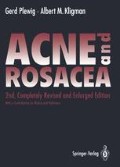Abstract
It is a popular conception that free fatty acids formed within sebaceous follicles are irritants which attack the follicular epithelium, thus causing breaks in the lining. Presumably sebum then flows out and provokes an inflammatory reaction. Theoretically a pustule could spring up in this way from a normal sebaceous follicle. However, with rare exceptions pustules originate mainly from preexisting comedones, whether these are visible or not. There is no doubt that sebum is a toxic material. Intradermal injection of a dilute suspension provokes within 24 h a tender, intensely red papule, lasting for many days. However, there is no proof that the normal follicular epithelium is leaky because of the toxicity of sebum. Spongiotic changes of the follicular epithelium are quite uncommon in our experience.
Access this chapter
Tax calculation will be finalised at checkout
Purchases are for personal use only
References
Dahl MGC, McGibbon DH (1979) Complement C3 and immunoglobulin in inflammatory acne vulgaris. Br J Dermatol 101:633–640
Lee WL, Shalita AR, Suntharalingam K, Fikrig SM (1982) Neutrophil Chemotaxis by Propionibacterium acnes lipase and its inhibition. Infect Immun 35:71–78
Puhvel SM, Sakamoto M (1977) A re-evaluation of fatty acids as inflammatory agents in acne. J Invest Dermatol 68:93–99
Puhvel SM, Sakamoto M (1977) An in vivo evaluation of the inflammatory effect of purified comedonal components in human skin. J Invest Dermatol 69:401–406
Puhvel SM, Sakamoto M (1978) The chemoattractant properties of comedonal components. J Invest Dermatol 71:324–329
Puhvel SM, Sakamoto M (1980) Cytotaxin production by comedonal bacteria (Propionibacterium acnes, Propionibacterium granulosum and Staphylococcus epidermidis). J Invest Dermatol 74:36–39
Scott DG, Cunliffe WJ, Gowland G (1979) Activation of complement — a mechanism for the inflammation in acne. Br J Dermatol 101:315–320
Webster GF (1990) Inflammatory acne. Int J. Dermatol 29:313–317
Author information
Authors and Affiliations
Rights and permissions
Copyright information
© 1993 Springer-Verlag Berlin Heidelberg
About this chapter
Cite this chapter
Plewig, G., Kligman, A.M. (1993). The Dynamics of Inflammation. In: ACNE and ROSACEA. Springer, Berlin, Heidelberg. https://doi.org/10.1007/978-3-642-97234-8_10
Download citation
DOI: https://doi.org/10.1007/978-3-642-97234-8_10
Publisher Name: Springer, Berlin, Heidelberg
Print ISBN: 978-3-642-97236-2
Online ISBN: 978-3-642-97234-8
eBook Packages: Springer Book Archive

